What are atomic orbitals - Study guides, Class notes & Summaries
Looking for the best study guides, study notes and summaries about What are atomic orbitals? On this page you'll find 668 study documents about What are atomic orbitals.
Page 3 out of 668 results
Sort by
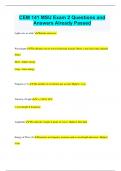
-
CEM 141 MSU Exam 2 Questions and Answers Already Passed
- Exam (elaborations) • 20 pages • 2024
- Available in package deal
-
- $9.99
- + learn more
CEM 141 MSU Exam 2 Questions and Answers Already Passed Lights acts as what? Particle and wave. Wavelength The distance (m) of waves from peak to peak. Short: x-ray (red), long: infrared (blue) Short - higher energy Long - lower energy Frequency (V) The number of wavefronts per second. Highest: x-ray Velocity of Light C = 3.00 X 10^8 = wavelength X frequency Amplitude The intensity, height of peaks of waves. Highest: blue light Energy of Wave (J) Increases as frequency i...
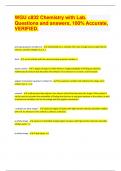
-
WGU c832 Chemistry with Lab. Questions and answers, 100% Accurate, VERIFIED | 28 Pages
- Exam (elaborations) • 28 pages • 2023
-
- $17.49
- + learn more
principal quantum number (n) - -symbolized by n, indicates the main energy level occupied by the electron. positive integers (1,2,3...) shell - -set of orbitals with the same principal quantum number, n. atomic orbital - -a region of space in which there is a high probability of finding an electron. mathematical function that describes the behavior of an electron in an atom, wave function. angular momentum quantum number (l) - -the quantum number that indicates the shape of an orbital. (0,...
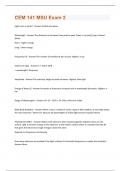
-
CEM 141 MSU Exam 2 Questions with 100% Correct Answers | Verified
- Exam (elaborations) • 12 pages • 2024
- Available in package deal
-
- $7.99
- + learn more
Lights acts as what? - Answer-Particle and wave. Wavelength - Answer-The distance (m) of waves from peak to peak. Short: x-ray (red), long: infrared (blue) Short - higher energy Long - lower energy Frequency (V) - Answer-The number of wavefronts per second. Highest: x-ray Velocity of Light - Answer-C = 3.00 X 10^8 = wavelength X frequency Amplitude - Answer-The intensity, height of peaks of waves. Highest: blue light Energy of Wave (J) - Answer-Increases as frequency increases and as wa...
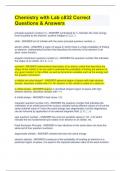
-
Chemistry with Lab c832 Correct Questions & Answers
- Exam (elaborations) • 29 pages • 2023
-
- $14.99
- + learn more
principal quantum number (n) - ANSWER symbolized by n, indicates the main energy level occupied by the electron. positive integers (1,2,3...) shell - ANSWER set of orbitals with the same principal quantum number, n. atomic orbital - ANSWER a region of space in which there is a high probability of finding an electron. mathematical function that describes the behavior of an electron in an atom, wave function. angular momentum quantum number (l) - ANSWER the quantum number that indicates t...
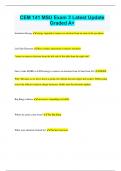
-
CEM 141 MSU Exam 3 Latest Update Graded A+
- Exam (elaborations) • 8 pages • 2024
- Available in package deal
-
- $9.99
- + learn more
CEM 141 MSU Exam 3 Latest Update Graded A+ Ionization Energy energy required to remove an electron from an atom in the gas phase Left Side Electrons have weaker attractions to remove electrons *easier to remove electrons from the left side of the table than the right side* Does it take MORE or LESS energy to remove an electron from Li than from Na? MORE Why? Because as we move down a group, the orbitals become larger and weaker. While going across the effective nuclear charge in...
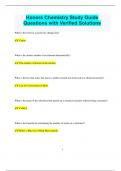
-
Honors Chemistry Study Guide Questions with Verified Solutions
- Exam (elaborations) • 11 pages • 2024
- Available in package deal
-
- $9.99
- + learn more
Honors Chemistry Study Guide Questions with Verified Solutions What is the term for a positively charged ion? Cation What is the atomic number of an element determined by? The number of protons in the nucleus What is the law that states that mass is neither created nor destroyed in a chemical reaction? Law of Conservation of Mass What is the name of the substance that speeds up a chemical reaction without being consumed? Catalyst What is the formula for calculating the nu...
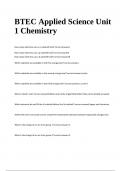
-
BTEC Applied Science Unit 1 Chemistry - Distinction.
- Exam (elaborations) • 31 pages • 2024
-
- $13.49
- + learn more
BTEC Applied Science Unit 1 Chemistry - Distinction. How many electrons can an s subshell hold? correct answer2 How many electrons can a p subshell hold? correct answer6 How many electrons can a d subshell hold? correct answer10 Which subshells are available in the first energy level? correct answers Which subshells are available in the second energy level? correct answers and p Which subshells are available in the third energy level? correct answers, p and d What is Hund's rule? correct ...

-
General Chemistry Chapter 1, 2, 3 Test Questions and Answers | Latest Update | 2024/2025 | 100% Pass
- Exam (elaborations) • 32 pages • 2024
- Available in package deal
-
- $11.01
- + learn more
General Chemistry Chapter 1, 2, 3 Test Questions and Answers | Latest Update | 2024/2025 | 100% Pass What is the principle behind using chromatography for separating mixtures? Chromatography separates mixtures based on the differential affinities of compounds for a stationary phase and a mobile phase, allowing components to be isolated and analyzed. How does the concept of entropy relate to the spontaneity of a chemical reaction? Entropy measures the disorder or randomness in a sy...

-
TEST BANK FOR ORGANIC CHEMISTRY WITH BIOLOGICAL TOPICS 6th EDITION ISBN : 9781260325294 ALL CHAPTERS INCLUDED.
- Exam (elaborations) • 957 pages • 2023
-
- $25.49
- + learn more
TEST BANK FOR ORGANIC CHEMISTRY WITH BIOLOGICAL TOPICS 6th EDITION ISBN : 9781260325294 ALL CHAPTERS INCLUDED. Chapter 1 1 MULTIPLE CHOICE QUESTIONS Topic: Atomic Orbitals 1. In quantum mechanics a node (nodal surface or plane) is: A) a place where Ψ is negative. B) a place where Ψ is positive. C) a place where Ψ = 0. D) a place where Ψ 2 is large. E) a place where Ψ 2 is negative. Ans: C Topic: Atomic Orbitals, Molecular Orbitals 2. When the 1s orbitals of two hydroge...
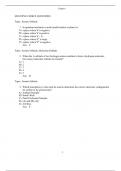
-
CHM 2210 Organic Chemistry TEST BANK
- Other • 956 pages • 2023
-
- $30.49
- + learn more
MULTIPLE CHOICE QUESTIONS Topic: Atomic Orbitals 1. In quantum mechanics a node (nodal surface or plane) is: A) a place where Ψ is negative. B) a place where Ψ is positive. C) a place where Ψ = 0. D) a place where Ψ2 is large. E) a place where Ψ2 is negative. Ans: C Topic: Atomic Orbitals, Molecular Orbitals 2. When the 1s orbitals of two hydrogen atoms combine to form a hydrogen molecule, how many molecular orbitals are formed? A) 1 B) 2 C) 3 D) 4 E) 5 Ans: B Topic: A...

How much did you already spend on Stuvia? Imagine there are plenty more of you out there paying for study notes, but this time YOU are the seller. Ka-ching! Discover all about earning on Stuvia


